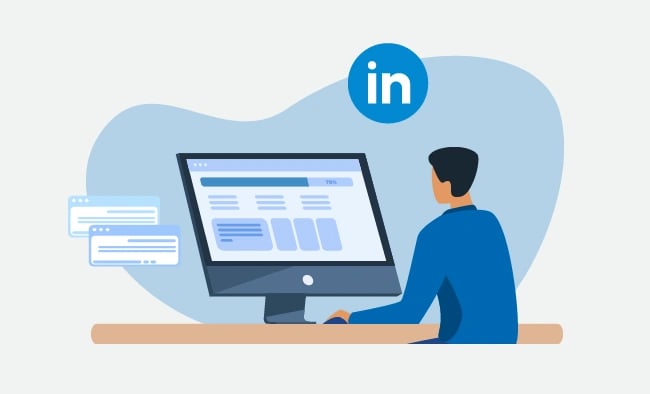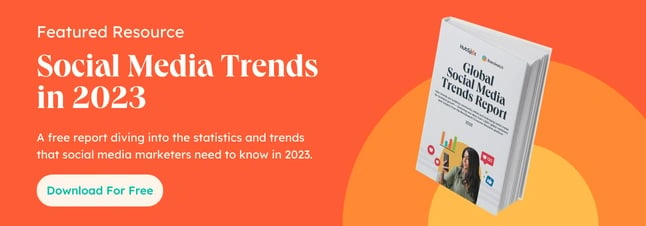Social Media Marketing: The Ultimate Guide
- September 9, 2023
- Knowledge Base
- 0 Comments

When it comes to social media, marketers’ top goals are advertising their products/services and increasing their brand awareness, according to 2021 HubSpot Blog Research.
However, many brands struggle with creating engaging content and reaching their target audience. With social media playing such an important role at the top of the funnel, let’s dive into all things social media marketing – what it is, its benefits, and how to actually build a social media marketing strategy that’ll work for your specific business.
What is social media marketing?
Social media marketing is the process of creating content for social media platforms to promote your products and/or services, build community with your target audience, and drive traffic to your business. With new features and platforms emerging every day, social media marketing is constantly evolving.
Social media marketing is all about meeting your target audience and customers where they are and as they socially interact with each other and your brand.
While social media marketing as a whole is incredibly valuable and beneficial to your business growth (as you’ll see in the following section), your strategy will differ based on which social networks your audience spends their time on.
Before we dig deeper into social media marketing, let’s segment the strategy by platform.
Social Media Marketing Platforms

- Users: 1.9 billion daily active users worldwide
- Audience: An even spread of Generation X and Millennials
- Industry impact: B2C
- Best for: Brand awareness; advertising; community building
Facebook is the largest social media platform and the most established. Since its launch in 2004, it has become an invaluable tool for B2C businesses, offering advanced advertising tools as well as organic opportunities.
Featured Resources:
TikTok

- Users: 1 billion active monthly global users
- Audience: Primarily Gen Z followed by Millennials
- Industry impact: B2B and B2C
- Best for: Short-form, creative video content; user-generated content; brand awareness
When you think of short-form video, you probably think of TikTok. The platform rose in popularity in 2020 and shows no signs of slowing down. It’s one of the best platforms for community building, with marketers ranking it in second place behind YouTube.
Featured Resources:

- Users: 1 billion monthly active users
- Audience: Primarily Millennials
- Industry impact: B2C
- Best for: High-quality images and videos; user-generated content; advertising
Although Instagram launched only 12 years ago, the platform has taken the world by storm. When it comes to sharing visually compelling content, Instagram is where brands go. Another thing that sets the platform apart is its advanced ecommerce tools.
Today, users can discover brands, browse their products and/or service, and complete a purchase without ever leaving the app – making Instagram a hard platform to beat.
Featured Resources:

- Users: 211 million daily active users worldwide
- Audience: Primarily Millennials
- Industry impact: B2B and B2C
- Best for: Public relations; customer service; community building
While Instagram focuses on visuals, Twitter focuses on words. Since the early days of 140-character Tweets, the platform has now expanded to include an audio tool called Twitter Spaces, a community-building tool called Twitter Communities, and Twitter Moments to share interesting content with your followers.
Featured Resource:

- Users: 774 million active users worldwide
- Audience: Baby boomers, Generation X, and Millennials
- Industry impact: B2B
- Best for: B2B relationships, business development, and social selling
LinkedIn is Facebook’s professional cousin. It’s perhaps the only platform where its audience is clearly defined: Working professionals looking to network and seek out new opportunities.
That makes it the ideal platform for B2B companies looking to identify key decision-makers and build an industry-specific community.
Featured Resources:
YouTube

- Users: Over 315 million daily active users worldwide
- Audience: Primarily Millennials but has a strong audience across gender and age demographics
- Industry impact: B2C and B2B
- Best for: Brand awareness; long-form entertainment; how-to and explainer videos; SEO; advertising
According to HootSuite, YouTube is the second most visited website in the world. In addition, marketers name it the best platform to build community.
In addition to being an incredibly popular platform, its users also tend to stay longer on it because it features mostly long-form content – making it an ideal platform to share educational content.
Featured Resources:
Snapchat

- Users: 306 million daily active users worldwide
- Audience: Primarily Generation Z
- Industry impact: B2C
- Best for: Brand awareness; advertising; location-based marketing
When Snapchat came out in 2011, leading the charge in ephemeral content. It introduced content that you could share with your friends and that would expire after 24 hours.
The platform peaked in 2015 and has held strong since then. Many thought the brand would disappear once Instagram introduced Stories, the same feature with a different name. However, Snapchat continues to be popular among young adults.
Featured Resource:

- Users: 444 million monthly active users worldwide
- Audience: Primarily Millennials with a solid audience in Gen Z, Gen X and Baby Boomers
- Industry impact: B2C
- Best for: Visual advertising; inspiration
Think of Pinterest like a visual storyboard that allows users to get inspiration for everything from fashion to home decor.
85% of Pinners say Pinterest is where they go to start a new project. In addition, 80% of weekly Pinners say they’ve discovered a new brand or product on the platform. So, not only is it a great discovery tool but it’s also a way for brands to build their narrative through visual stories.
Featured Resources:
Clubhouse

- Users: 10 million weekly active users worldwide
- Audience: Primarily Millennials
- Industry impact: B2B and B2C
- Best for: Visual advertising; inspiration
Clubhouse made a strong impression as soon as it entered the social media world in 2020. The audio-only platform allows people to start interesting conversations with followers as well as strangers and build community.
The platform also gained some buzz for its invitation-only set up when it was in beta testing. Today, the platform is open to everyone globally and on both IOS and Android devices. Another big selling point to this platform is that it works well for both B2B and B2C businesses and leverages audio, which has made a huge comeback in recent years.
Now that we’ve detailed the fundamentals of each social media network, let’s discuss why social media marketing is beneficial for your business.
Featured Resources:
Benefits of Social Media Marketing
To illustrate the benefits of social media marketing, let’s take a look at the experience from the user’s perspective. Well, my perspective.
As I scroll through my Instagram feed every day (cough, cough…multiple times a day), I consistently notice new posts and stories by The Frye Company. I’ve always been a fan of their boots, clothing, and accessories, but I also love the content they share on their Instagram profile.
All of their photos have the same filter on them to ensure they match — this makes their profile look professional, artistic, and organized when visitors, like myself, browse their page.
Frye’s account also encourages interaction between the company and its followers by providing them with a specific hashtag to use so they can be featured on the page when they post photos with Frye products.
Frye’s Instagram account is a great example of successful social media marketing — it’s attractive, distinctly Frye, engages their ~200K followers, and promotes their products.
But why is social media marketing so important? And how do you actually build a social media marketing strategy that’ll work for your specific type of business?
There are a variety of reasons why your company should use social media marketing. We’ve created a list of the most beneficial reasons to consider.
Let’s dive in.
1. Increase your brand awareness.
Due to the sheer amount of people on social media, you’re missing out on the potential to reach thousands, and even millions, if you don’t have a presence.
In fact, social media has been proven to boost brand awareness by driving up engagement. Social engagement includes things like comments, likes, shares, and reposts, and saves.
It also helps you increase brand awareness by directing traffic straight to your site. You can do this by including links to your website and other offers in your profile, bio, and posts.
Featured Resource
2. Generate leads and boost conversions.
Promoting and sharing your products on social media is a simple way to improve lead generation, boost conversions, and increase sales because you’re advertising to people who have opted to engage with you by following your account.
Here are some examples of ways you can use social media to generate more leads.
- Create contests for your visitors and followers to participate in on your social media profiles.
- Include links to your website and offers in the bio sections of your profiles.
- Host live videos to make announcements about products and provide updates or details about exciting news at your company.
- Implement a social media marketing campaign on one of your channels.
- Sell your products through your social profiles. For example, you can enable Facebook’s Shop Section or Instagram’s Shopping feature on your profiles. These features allow your visitors and followers to click on products you’ve shared in posts to view information such as price, material, and size. Then, visitors can easily proceed to checkout through the platform and buy the product directly from you.
3. Foster relationships with your customers.
By connecting and engaging with your social media followers, you’ll be able to build lasting relationships between them and your business. You can do this by interacting with them on your posts, responding to their questions and comments, and providing them with any help they may need.
You can also ask your followers questions about your products, their pain points, or create giveaways to help you build trust and show them how much you value their input and support.
4. Learn from your competitors.
Social media is a great way to keep tabs on your competitors — whether that’s in reference to their social media tactics, the products they’re promoting, the campaigns they’re implementing, or their level of interaction with followers.
Social media allows you to get a look at what is and isn’t working for your competition, and therefore helps you decide what should or shouldn’t change in terms of your company’s approach.
Lastly, reviewing the social accounts of your competitors can help you make sure your marketing stands out and is unique to your brand.
Learn how to conduct a competitive analysis to discover how you can beat the competition.
Now, let’s talk strategy — there are several steps to ensure your social media marketing plan is sustainable and positively impacts your business.
How to Create a Social Media Marketing Strategy
Set clear goals. Research your buyer personas and audience. Determine which social platforms you’ll market on. Establish your most important metrics and KPIs. Get to know your competition. Create unique and engaging content. Organize a schedule for your posts. Review and adjust your strategy.
Although social media is constantly evolving, most of the foundational steps you need to succeed stay the same. Essentially, you’re following the same steps you would take to create a marketing strategy and narrow it to a specific channel.
Let’s cover these steps in more detail so you can begin applying them to your business.
Step 1: Set clear goals.
The first step to creating a social media marketing strategy is to define your social media goals and ensure that they align with your overall business objectives.
Ask yourself: What do you want to achieve through your social media efforts? Examples could be increasing brand awareness, driving website traffic, generating leads, boosting customer engagement, or improving customer satisfaction.
Once you’ve set your high-level goals, break them down into smaller, actionable steps. This helps you identify the specific actions and strategies needed to achieve your goals. For example, if your goal is to increase website traffic through social media, actionable steps could include increasing posting frequency, optimizing content for sharing, or running targeted ad campaigns.
Recommended Resources:
Step 2: Research your buyer personas and audience.
After establishing some goals, determine who your buyer personas and audience are so you can target their needs and interests appropriately.
To do this, think about the people you’re trying to reach and why, and how you would classify them as a group. For example, if your company sells trendy leggings and joggers, you might classify your target audience as millennials who like to wear stylish athletic apparel regularly — a style known as athleisure.
By considering your buyer personas and audience, you’ll then be able to determine what content will attract the type of followers and customers you hope to gain. Plus, learn how to create engaging content to keep your followers interested.
Pro Tip: Consider gathering feedback from your followers to get insights into their preferences, pain points, and satisfaction levels. This data can help you identify areas for improvement and refine your buyer personas.
Recommended Tools
Step 3: Determine which social platforms you’ll market on.
As a social media marketer, it’s crucial you determine which platforms you’re going to share your content on.
There’s not necessarily a right or wrong answer when it comes to which social channels your business should use — it’s more about the needs of your target audience and where they tend to spend their time.
“It’s important to be where your audience of potential customers is today, and where they might be tomorrow,” said Andrew Delaney, former social media marketing manager at HubSpot. “It’s better to be ahead of the curve than behind.”
For example, if you are going for that target audience of athleisure-loving millennials, you may want to focus the majority of your social media efforts on Instagram — this is because millennials cover the largest portion of users on the platform.
Stephanie Morgan, founder and CEO of social media agency Social Lock, echoes this sentiment.
“Think about their behaviors and where they hang out online. If that’s Pinterest, use that platform for your brand. If that’s TikTok, use that platform for your brand,” Morgan adds. “Don’t waste time on a platform that your ideal client avatar is not very active on.”
Recommended Tools and Resources
Step 4: Establish your most important metrics and KPIs.
No matter your goals or industry, your social media strategy should be data-driven.
That means focusing on the social media metrics that matter. Rather than focus on vanity metrics, dig into data that aligns directly with your goals.
What metrics are we talking about? Check out the breakdown below:
- Reach. Post reach is the number of unique users who saw your post. How much of your content actually reaches users’ feeds?
- Clicks. This is the number of clicks on your content or account. Tracking clicks per campaign is essential to understand what drives curiosity or encourages people to buy.
- Engagement. The total number of social interactions divided by the number of impressions. This sheds light on how well your audience perceives you and their willingness to interact.
- Hashtag performance. What were your most-used hashtags? Which hashtags were most associated with your brand? Having these answers can help shape the focus of your content going forward.
- Organic and paid likes. Beyond a standard “Like” count, these interactions are attributed to paid or organic content. Given how much harder organic engagement is to gain, many brands turn to ads. Knowing these differences can help you budget both your ad spend and the time you invest in different formats.
- Sentiment. This is the measurement of how users react to your content, brand, or hashtag. Did customers find your recent campaign offensive? What type of sentiment do people associate with your campaign hashtag? It’s always better to dig deeper and find out how people talk or feel about your brand.
Recommended Resources
Step 5: Get to know your competition.
A competitive analysis allows you to understand who the competition is and what they’re doing well (and not so well). You’ll get a good sense of what’s expected in your industry, which will help you set social media targets of your own.
It will also help you spot opportunities.
Maybe one of your competitors is dominant on Facebook, for example, but has put little effort into Twitter or Instagram. You might want to focus on the networks where your audience is underserved, rather than trying to win fans away from a dominant player.
Pro Tip: Consider monitoring your competitors’ customer reviews to gain insights into what their customers like and dislike about them. Pay attention to common complaints or recurring themes to understand their pain points, and aim to solve those pains in your own strategy.
Recommended Tools and Resources
Step 6: Create unique and engaging content.
With the billions of social media users around the globe, there’s no question that at least some of your followers — or the people browsing your profile — have also seen your competitor’s content or that of other businesses in your industry.
That’s why you must have engaging social media content that stands out and provides viewers with a reason to click that “Follow” button and interact with your brand.
Not sure what’s considered engaging? Morgan has a recommendation.
“My number one tip to brands for creating engaging content on social media is to do market research first because what will be engaging depends on the audience,” Morgan said. “When you know what your audience likes and needs to know, you can create content that engages those interests.”
To help you get creative, consider the content your competitors are sharing and how you can uniquely promote your products. Also, take advantage of the features offered by the platform you’re using.
For example, you can create live videos on Facebook to share the latest details about a product launch or conduct a giveaway.
You can also use your current customers and promoters to help you generate content. You can do this by re-posting their content or encouraging them to use a hashtag to share their own experiences and pictures with your products.
Lastly, leverage trends. Social media trends are always coming up, especially on short-form video platforms like TikTok. Don’t be afraid to join in but you still have to be intentional about how you do it.
“If the trend started happening three weeks ago, you’ve probably missed the boat,” Morgan said. “Catching the trends early is the best way to capitalize on it without coming across as inauthentic or like you’re trying too hard, or worse [as] ‘chuegy’ – see Gen Z for that one.”
Recommended Tools and Resources
Step 7: Organize a schedule for your posts.
One of the easiest ways to ensure your content is shared as planned is to use a social media management solution. These tools allow you to write captions, prepare pictures and videos, and schedule posts in advance. They also automatically share your content on schedule and monitor all post interactions and engagement for you. Social media management solutions save you time and allow you to focus on your other tasks.
There are a number of solution options available — here are a few examples.
HubSpot
HubSpot offers a social media tool — as part of the marketing software — to help you publish and monitor your content and create real connections with your followers. You can schedule and publish your content in advance and compare in-depth reports on your posts’ engagement to understand the performance of various platforms, types of content, and posting times.
Sprout Social
Sprout Social is a social media marketing and management solution designed to help your team organize and plan content creation, manage campaigns, understand engagement, and review content reports and analysis.
Hootsuite
Hootsuite is a social media management platform for finding, scheduling, managing, and reporting on your content. You can schedule posts in advance on all of your channels at once and measure your ROI with comprehensive content analysis.
How often should you post on social media?
Now, you might be wondering how often you should post content on your social media channels.
As a rule of thumb, you should only post on social media when you have quality content to share. Meaning, there’s a reason you’re posting the content. This is how you’ll strike the right balance when it comes to your posting frequency.
Morgan says the top mistake she sees brands make in regards to social media marketing is focusing on quantity of content instead of the quality of content.
“They think they need to post every day, so they force themselves to create posts to fill up the calendar,” she said. “Odds are, every single one of those posts isn’t going to be very valuable to the ideal customer, I’ve coined this ‘clutter content.'”
Instead, she recommends downsizing in quantity and upping the quality.
“It’s better to post two or three times a week with super valuable content, versus posting seven times a week with only one or two valuable posts,” said Morgan.
There are plenty of studies and resources available explaining social media post frequency standards by industry and platform for you to follow. Every business is different, so find what works for your audience.
Then, you can begin experimenting with more or fewer posts – as well as other factors such as the time of day you’re posting on social – to determine what provides the highest level of engagement.
Recommended Tools and Resources
Step 8: Review and adjust your strategy.
Social media is always evolving, so it’s important to periodically check in and make sure your strategy is still effective.
Consider setting a regular cadence for reviewing your social media strategy. This could be monthly, quarterly, or annually, depending on your business needs and resources. Use these reviews to determine what’s working, what needs improvement, and what new opportunities to explore.
When conducting these reviews, take the time to assess whether you’re making progress towards your social media goals and objectives. Compare your actual performance against the benchmarks and KPIs you established. Then, identify any gaps or areas that need improvement.
It’s also important to keep up with the latest trends. Be sure to monitor changes in social media algorithms, user behavior or new features, as well as emerging platforms and technologies.
For instance, if you heavily use Twitter as part of your social media strategy, consider the implications of the platform’s rebrand to X and the new competitors that have emerged since Elon Musk purchased it.
How to Analyze Your Social Media Marketing Impact and Results
One of the most important aspects of social media marketing is ensuring your efforts are successful in helping you meet your goals. To determine this, you’ll need to keep track of all of your posts, on every channel. You can do this by reviewing and managing your social media metrics.
Social Media Metrics
Social media metrics are data related to the success of your posts and your impact on your audience and customers on various platforms. These metrics may include data about your level of engagement, likes, follows, shares, and all other interactions on each platform.
Here are 10 of the most important metrics for you to track:
- Engagement: This includes clicks, comments, likes, and replies on your social media posts. There are also platform-specific types of engagement such as “Saved” posts on Instagram and “Pinned” posts on Pinterest.
- Reach: The number of people who have seen any content associated with your page or profile is your reach.
- Followers: This is the number of people you have on your profile who have clicked your “Follow” button and see your content in their feeds regularly.
- Impressions: This is the number of times a post from your profile or page is seen, whether or not your audience members click on it. This is often what happens when someone is scrolling through their newsfeed, but not clicking on anything.
- Video views: On Facebook, Snapchat, Instagram, or any other social channel with video capabilities, this is the number of views each gets.
- Profile visits: The number of people who have opened your social media page is your number of profile visits.
- Mentions: This is the number of times your profile has been mentioned by audience members in their posts.
- Tags: This is when your audience adds the name of your company’s profile or your hashtag to another post.
- Reposts: This is when a member of your audience posts a piece of your content on their profile.
- Shares: These are the posts your followers and audience take from your profile and share with their network.
You can influence all of these metrics, increase your social following, and improve overall engagement on your profile by using the same tactics you would to generate leads and boost conversions.
Morgan adds that the metrics you focus on will depend on which season you’re in. Here’s her formula:
- If you’re new, focus on building an audience and awareness. Key metrics: reach, impressions, audience growth.
- If you’re growing, focus on building trust. Key metrics: Likes, saves, comments, DMs.
- If you’re established, focus on retaining and nurturing. Key metrics: Likes, saves, comments, DMs.
- If you’re launching something, focus on selling. Key metrics: DMs and clickthrough rate
How to Measure Social Media Metrics
You can review social media metrics in a variety of ways, For example, you can use the analytics tools built into the various platforms you use. Here are a few examples:
You might also choose to use an analytics and tracking tool such as Google Analytics. This is a great option if you want to track your social media and website metrics. Lastly, many social media scheduling solutions — as we reviewed earlier — have monitoring and tracking features automatically built-in.
All of these metrics tracking tools will give you a better understanding of what your followers and audience respond well to and what you should consider modifying to improve engagement.
Now that we’ve reviewed the benefits of social media marketing and how to build your strategy, let’s talk about the various resources available to help you along the way.
Social Media Marketing Resources
There are a plethora of social media marketing resources you can use to build a social strategy for your company. You’re bound to feel more confident about working on your company’s social media marketing initiative with the help of the following courses, training, and books.
Social Media Marketing Courses and Training
Here are three ways to earn an education in the field of social media marketing if you feel it’s necessary for your specific business situation.
1. Earn a certificate administered by a company.
A certificate is a quick and simple way to gain a deep understanding of social media marketing courses.
HubSpot offers a free social media certification course, which teaches you how to engage with your customers and improve conversions. You’ll also get a better understanding of how to develop your strategy, extend your reach, and measure your social media ROI.
LinkedIn Learning is another platform where you can earn a certification and share it on your profile.
2. Leverage YouTube university.
YouTube is a goldmine when it comes to educational content.
With a quick search, you’ll find hundreds of long-form videos that offer in-depth courses on social media marketing. Granted, you can’t connect with a live educator. However, it’s free and can be a great starting point before you dive into a paid course.
Social Media Marketing Books
Reading relevant content about social media marketing is another great way to learn more about the field. Here are a few examples of some highly-regarded books on the topic.
1. Likable Social Media, Third Edition: How to Delight Your Customers, Create an Irresistible Brand, and Be Generally Amazing on All Social Networks That Matter by Dave Kerpen
This New York Times Bestseller covers the reasons why being likable and engaging with followers on social media is one of the most powerful ways to grow your base of customers and promoters.
The book teaches you how to make impactful content for your followers to interact with and share with their networks. Author Dave Kerpen also describes why you need to ensure you’re consistently delighting your followers to avoid losing them at any point in time.
2. Jab, Jab, Jab, Right Hook: How to Tell Your Story in a Noisy Social World by Gary Vaynerchuk
According to author Gary Vaynerchuk, the key to social media marketing success isn’t about pushing out a lot of content — it’s about pushing out specific content tailored towards your target audience and using the right platform to do so.
In his book, Vaynerchuk covers how to do this as well as connect with your followers and customers on a deeper level through social media. You’ll learn how to create memorable and unique content that stands out in comparison to the competition’s content.
3. The B2B Social Media Book: Become a Marketing Superstar by Generating Leads with Blogging, LinkedIn, Twitter, Facebook, Email, and More by Kipp Bodnar
HubSpot’s CMO, Kipp Bodnar, writes about the ways B2B businesses can generate more leads and conversions through social media marketing.
There are actionable methods you can take to increase your base of followers and drive leads as well as understand the ROI of various B2B social media marketing strategies.
Emerging Social Media Platforms
Recent HubSpot Blog Research found that marketers are constantly on the lookout for new or emerging platforms, as often as even week.
Though it takes a while for platforms to take off, once they do, you want to have a plan in place for how you’re going to tackle it.
For instance, brands like Chipotle were one of the first to try short-form video content on TikTok. As a result, they have a strong presence on the platform while many others are still struggling to find their place.
Emerging platforms can offer a new avenue to reach your target audience in a way that may be more effective than what you’re doing now. Clubhouse and Discord are among some of the most popular emerging platforms.
However, others like Flyy and SpaceHey are looking to make their mark.
Want to learn more about what’s out there? Check out this article on new social media platforms you should keep your eye on this year.
Start Marketing on Social Media
Considering there are billions of people on social media today, it’s easy to see why so many businesses and marketers use the channel to promote their products and engage with customers.
Although determining your company’s social media course of action may seem daunting, you can avoid feeling overwhelmed by understanding social media marketing trends and using some of the many resources available about the topic. So, start working on your business’ social media marketing strategy today to increase your number of followers, improve engagement, and boost conversions.
Editor’s note: This post was originally published in March 2019 and has been updated for comprehensiveness.

![Download Now: The 2023 State of Social Media Trends [Free Report]](https://no-cache.hubspot.com/cta/default/53/3dc1dfd9-2cb4-4498-8c57-19dbb5671820.png)



